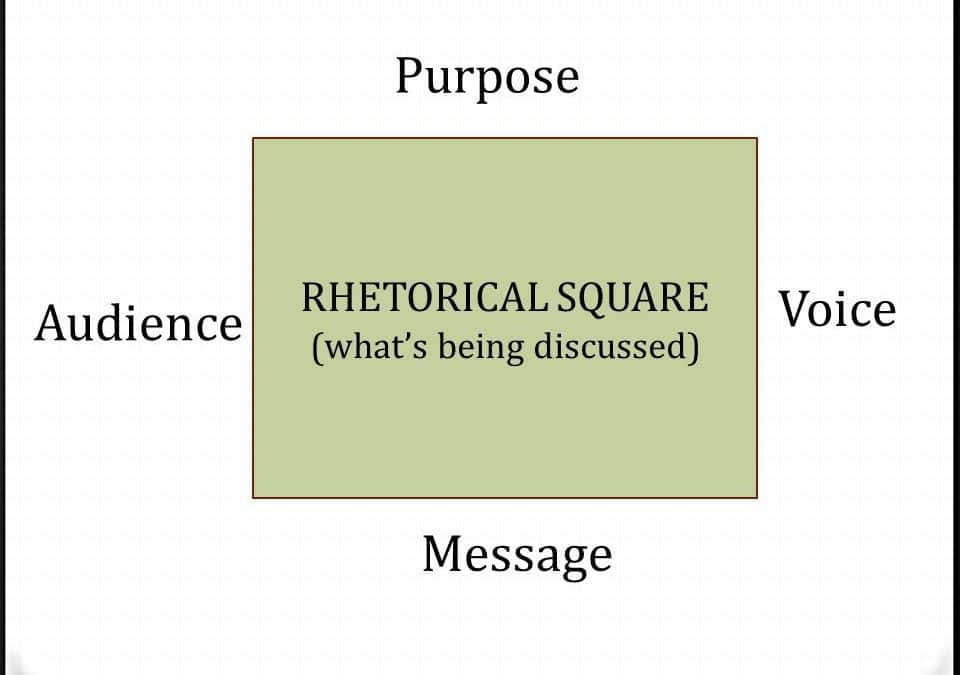What is rhetoric?
Rhetoric is the art of persuasion. Why is it an art? Well, to be a good rhetorician, you’ve got to be convincing, and being convincing involves knowing your audience and shaping your argument in a way that will be persuasive to that audience. When you want to convince someone of something, chances are you’ll be employing rhetoric to do so.
The SAT Essay asks you to analyze how authors use rhetoric to persuade the reader to agree with them. In addition to analyzing rhetorical devices, you’ll want to make sure you consider these 4 elements of rhetoric. Today, we’ll take a look at the rhetorical square, which is comprised of the 4 elements you should consider when analyzing a text.
The Rhetorical Square

The Rhetorical Square consists of four elements that matter when analyzing a text.
The four elements are: 1) Purpose, 2) Message, 3) Audience, and 4) Voice.
1) Purpose
The first element of the rhetorical square is PURPOSE. Purpose has to do with WHY a text exists. What’s the point? What’s the purpose? When you understand what it is that motivates the writer to make his or her argument, you’ll be well on your way to analyzing the rhetorical choices the writer makes in order to convince the reader that his or her argument is sound. All of the writer’s choices will make sense in light of that writer’s purpose, so be sure you’re able to correctly identify it when analyzing a text.
No matter what text you’re dealing with, there’s a purpose for that text. Try to identify WHY the author is writing. Some possible purposes for texts could be…
To persuade someone to buy something.
To persuade someone to do something.
To persuade someone to think something.
To prove something’s true.
To disprove something.
When reading, always ask yourself WHY the author is writing the piece? What does he or she hope to achieve? What are they hoping to convince us?
And when you’re writing, it’s very important to consider YOUR purpose for writing. When you know your purpose, you’ll be better equipped to persuade the reader.
2) Message
Every day, we hear many messages. “Buy this,” “do that,” “Please RSVP,” “Like and share,” “Vote for so-and-so,” and so on. Messages can often be quite simple, but they can also be subtle and complex. For example, we might see a celebrity on TV endorsing a haircare product. The message is, I’m a celebrity, I use this haircare product, you want to be like me, so use this haircare product. When you read a text, take to identify what the writer’s message is.
What exactly is the writer hoping to get across? Why does the writer believe that this message is significant to readers? How does the message affect me? How might it affect other readers? What consequences will arise as a function of agreeing with the author and acting accordingly? What is at stake?
In most pieces of writing, especially academic writing, the message is the most important thing. We focus all our attention on what it is we want to say. There are many ways to convey a message and to strengthen it, and these methods include rhetorical devices and persuasive techniques. If you’re telling an anecdote or making an emotional appeal, chances are they’ll both be in service to the message you’re trying to get across.
3) Audience
This is a very important element of the rhetorical square! Writers need to be conscious of their audience when writing a text, and readers need to be conscious of the writer being conscious of his or her audience. Why does audience matter? Well, depending on your audience, you might say or do different things in an effort to persuade them. Different audiences might necessitate different strategies, different voices, different tones, different diction, different techniques. An audience of literary theorists will likely read a paper different than an audience of high school freshman. If you’re talking to your mother-in-law, you might speak differently than you do when talking to your best friend. The best rhetoricians will have carefully considered their audience before deciding the most effective methods to persuade that audience.
As readers, we can ask ourselves: Who is the intended audience for this piece? Is it a specific audience? A general audience? Is the writer aware of his or her audience? Is the writer making any choices specifically designed to appeal to this audience? Is the writer ignorant of his or her potential audience? All of these factors, and more, come into play when analyzing rhetoric.
As writers, it’s vital to have our intended audience in mind. Who might be reading our piece or listening to our argument? What techniques will appeal to these readers or listeners? Most people want to be spoken to in a language they can understand. If you’re writing for a general audience, it’s important not to use highly technical terms and leaving those terms unexplained. On the other hand, if you’re writing for a highly specialized audience, the types of claims you’ll make and the diction you use may be different.
4) Voice
The last element of the rhetorical square that we’ll discuss today is voice, and voice is quite important!
All texts can be said to have a “voice,” and the voice of a text is shaped by a variety of factors. A lawyer writing or speaking to another lawyer might use a very different voice than a toddler trying to persuade his mother to get him an ice cream cone. Audience and voice are closely linked; one shapes the other. By considering your audience, you’ll be ready to tailor your voice to that audience’s beliefs, intelligence, needs, desires, and so on.
As readers, we want to pay attention to the author’s voice. How does he or she write or speak? What type of tone does he or she take? What type of diction does the author use? Ask yourselves these questions during your reading and note-taking process, and when you need to write an analytical essay, be sure to discuss the nuances of how voice is employed in service of a message!
* * *
That’s it! Remember to keep the rhetorical square in mind whenever you’re reading an argumentative text or listening to a speaker make an argument. A thoughtful consideration of purpose, voice, audience, and message will lead you to a greater understanding of the speaker’s persuasive techniques. For more essay-writing tips, as well as plenty of SAT and ACT prep tips to help you ace the big test, check out the rest of our blog. Looking for 1-on-1 tutoring or small group SAT or ACT classes? Contact us today.
